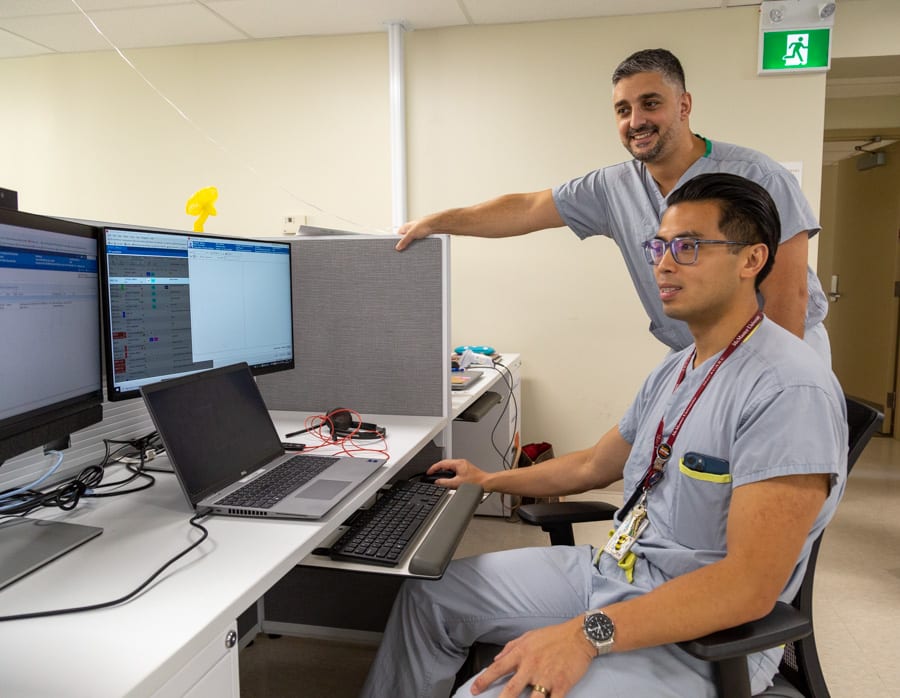
Dr. Ben Tam, foreground, shows Orthopedic Surgeon Dr. Anthony Habib some of the features of Niagara Health's new hospital information system, launching in November. Dr. Tam is the digital strategy physician lead on the project.
When Dr. Ben Tam and his wife welcomed their eldest daughter in 2017, their care team at St. Joseph’s Healthcare in Hamilton brought more than well wishes with them into the Tams’ hospital room.
They came equipped with laptops and barcode scanners that connected to a new hospital information system (HIS), which went live the same day. They were tools to help the care team access and build digital health records that would ultimately enhance the quality of care the Tams and every other patient would receive by standardizing processes and ensuring seamless information sharing between clinical teams at all St. Joe’s sites.
It meant the Tams didn’t have to re-tell their story when someone new joined their care team. The same was true when they returned to St. Joe’s for follow-up appointments.
The benefits didn’t end there. At work, Dr. Tam, who happened to be doing his residency in internal medicine and critical care at St. Joe’s, no longer had to reconcile notes from other doctors or sift through information in a patient’s Emergency Department chart to create a plan for those who came into his care.
He and everyone on a patient’s care team had a single, holistic record to work from that included information such as diagnostic imaging, blood work, medications and allergies.
Ultimately, the new HIS did away with the patchwork of handwritten and electronic recordkeeping and booking systems previously used at the hospital and replaced it with a one-stop shop for physician and patient information.
“With charts everywhere, paper everywhere and multiple sources of information, a lot of your job with the old system is retrieving information and interacting with patients for their story,” Dr. Tam recalls. “With this, you start off knowing the patient a lot better than you did without the system. Everything was in a single source of truth so you could meet the patient and immediately move on to validate and verify.”
The experience was so impactful that today Dr. Tam serves as Niagara Health’s digital strategy physician lead as it prepares to launch its own HIS with all the same benefits on Nov. 9. He recalls learning curves for physicians and patients at St. Joe’s as they adjusted to the new system but their trajectory led to welcome change, especially when it came to patient care.
Dr. Tam anticipates the same outcome at Niagara Health and at Hotel Dieu Shaver Rehabilitation Hospital, which is joining NH in leveraging the benefits of modern technology to ensure both hospitals continue to provide the safest, top-tier care.
“It’s a big change for us and patients, but the main message patients see from this transition is that we’re being professional and updating our processes to take care of them in the best way possible,” he says.
By the time Dr. Tam’s second child was born at St. Joe’s in 2019, the HIS was fully incorporated into practice across all hospital departments. Not only was he a seasoned parent by then, he was an HIS veteran keen to see the technology spread. He didn’t hesitate when the opportunity arose to help Niagara Health navigate this important change in operations.
“There are a couple of opportunities life will throw at organizations and when they come, you’ve got to take it. This is one of those opportunities,” Dr. Tam says. “Without technology and innovation matched to the appropriate workflows, we’ll flounder.”
The benefits of Niagara Health's Hospital Information System (HIS)
- Provide easy access by care teams to a patient's medical record, including information about their condition, allergies, medications, past visits and more.
- Enhance patient safety by eliminating the need to search for a patient's chart, write paper orders or decipher handwriting. Care providers also have access to the information they need to inform their health decisions. reducing the risk of errors.
- Reduce duplication and repetition by offering just one source of truth. Patients won't need to repeat their health history or story over and over, and all of their care providers will have access to the same information, including diagnostic tests, medications and other important knowledge.
- Enrich patient communication by enabling patients to access their own health records and resources, allowing them to share that information with other healthcare practitioners. They can also access health education materials and, in collaboration with other Niagara Health digital tools, communicate securely with their care team.
- Allow data to drive decisions by using analytics, trends and other important data to offer clinical direction and allow for alerts. This will make care more efficient and optimize decision-making.

